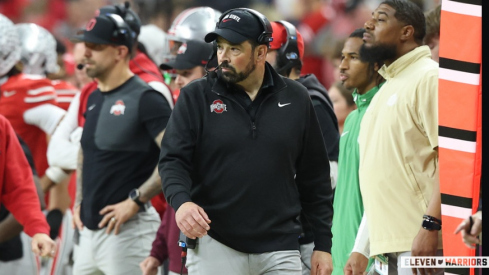If the Big Ten didn’t have divisions, Ohio State wouldn’t have had to wait a year for a shot at revenge against Michigan following November's rivalry loss.
Since Ohio State and Michigan were the only Big Ten teams that finished the 2021 season with one loss in conference play, the Buckeyes and Wolverines would have played again just one week later in the Big Ten Championship Game.
If you’re a traditionalist, the idea of Ohio State playing Michigan in back-to-back weeks instead of just once a year might seem like sacrilege, but that might soon become a real possibility.
According to a report by The Athletic’s Scott Dochterman, Big Ten leaders have had “serious discussions” about scrapping the conference’s two-division structure as soon as 2023. Instead, each Big Ten team would have only three opponents that it would play every year, while it would play five of the other 10 Big Ten schools on an alternating basis of either every other year or two years on and two years off.
That would make both Big Ten Championship Game berths available to every team in the conference, with the two teams with the best records in Big Ten play earning trips to Indianapolis, and that would likely mean more trips to Lucas Oil Stadium for the current powers of the Big Ten East – especially Ohio State.
Ohio State has already been the dominant team of the Big Ten Championship Game era, making six of the last nine conference title games, with five of those coming since the Big Ten eschewed Legends and Leaders divisions in favor of East and West. Had the Big Ten Championship Game been divisionless, however, Ohio State would have made all but one of the last nine conference title games, as it finished with the second-best record in the conference in both 2016 and 2021.
The 2018 Big Ten Championship Game, in which Ohio State faced Northwestern, would have also been an Ohio State-Michigan rematch – assuming, in this scenario, that head-to-head results would remain a primary tiebreaker – as all three teams finished with 8-1 conference records but the Wolverines held the head-to-head tiebreaker over the Wildcats.
In a divisionless conference, the top teams in the Big Ten East – namely Ohio State, Michigan, Penn State and Michigan State – could also benefit from not having to play all three of each other every year. Since the conference realigned into East and West divisions in 2014, at least half of each of those four teams’ Big Ten losses have come in games against each other.
That said, it’s far from guaranteed that eliminating divisions would actually make those teams’ schedules easier, as that could depend on which three teams they have as perennial opponents. It’s a given that Ohio State would continue to play Michigan and Michigan would continue to play Michigan State every year. It’s presumable that Ohio State would also continue to play Penn State every year, seeing as that game has also taken on a rivalry game feel in recent years (even if Buckeye fans don’t want to acknowledge the Nittany Lions as a rival), while Penn State vs. Michigan State is also a matchup the Big Ten would likely seek to preserve.
No longer playing all three of Indiana, Maryland and Rutgers every year could also take away some easy conference wins, as all three of those teams have typically been punching bags for the Buckeyes, who haven’t lost to any of them – they’ve never lost to Maryland or Rutgers – since they fell to Indiana in 1989.
And while reaching the Big Ten Championship Game could theoretically become a bit easier for Ohio State and the other Big Ten East powers if the conference goes divisionless, it could make actually winning the Big Ten Championship Game harder, considering that the East is 8-0 against the West in Indianapolis since the divisions were realigned in 2014.
From the perspective of Big Ten leadership, the big incentive for ensuring the teams with the two best records make the conference championship game would be increasing the likelihood that the winner of the Big Ten Championship Game makes the College Football Playoff regardless of who wins. That could be especially true if the CFP expands to an eight- or 12-team format in which the highest-ranked conference champions – but not necessarily every Power 5 conference champion – are guaranteed playoff berths, and Iowa athletic director Gary Barta told The Athletic that the Big Ten’s decision on whether to eliminate divisional play will be guided in part by “what gives us the best opportunity to have the most success in the College Football Playoff format.”
From a fan’s perspective, a schedule in which every Big Ten team plays every other Big Ten team at least twice every four years would add more variety to the schedule, creating regular matchups between every team in the conference at both of their home stadiums.
How much Ohio State and the Big Ten East’s other typical contenders would really benefit from a football standpoint is uncertain, but eliminating divisions might be the best way to resolve the imbalance of power that currently exists in the league – one that only seems poised to grow in the years to come, considering that the 2022 recruiting classes of all seven Big Ten East teams rank among the top eight in the conference (with sixth-place Iowa being the West’s highest-ranked team), per 247Sports’ composite team rankings.


